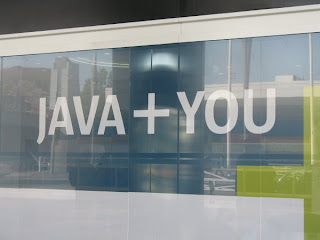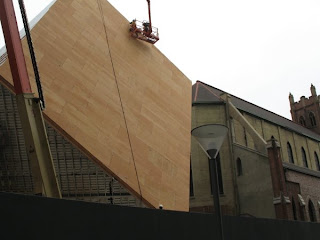 It’s May in San Francisco and that usually means one thing: it’s time for JavaOne. JavaOne is a chance for me to connect with people I’ve been working with but have only an email relationship with. How fun to shake a hand and share a moment! There’s the inside view (the talks, the booths, the lunches held in the deep caverns of Moscone Center) and the outside view (the City, the hang outs, the street). So, here’s the outside view.
It’s May in San Francisco and that usually means one thing: it’s time for JavaOne. JavaOne is a chance for me to connect with people I’ve been working with but have only an email relationship with. How fun to shake a hand and share a moment! There’s the inside view (the talks, the booths, the lunches held in the deep caverns of Moscone Center) and the outside view (the City, the hang outs, the street). So, here’s the outside view.Last year at JavaOne I walked past the future home of the Contemporary Jewish Museum. Each day I saw changes as the cranes and other heavy equipment constructed the beginnings of this most interesting building.

This year at JavaOne, while still not yet complete, I witnessed progress and marveled at the transformation of this cube seemingly balanced on one of its corners.

The area around Moscone Center and Yerba Buena Gardens has cityscapes that play with shapes and architecture that melds old and new.
Our hotel, the Union Square Hotel, is a stone’s throw from the Powell-Market cable car start—the turntable. The hotel just finished a major renovation; indeed, they finished laying carpet in the lobby the day we arrived. Right next door is a great greasy spoon breakfast place: Tad’s Steaks.

And what about JavaOne (the inside view)? Each year that I attend I’m in the middle of a project that pulls me into different parts of the technology. In previous years it was Sun’s web application platform (JSF) and Ajax. With Ajax came JavaScript.

This year, I was focused on scripting languages in general, JavaScript in particular, and social networking. There were two talks that were stand outs for me.
First, Chris Schalk from Google and Paul Lindner from hi5 gave an engaging talk on the OpenSocial container. (OpenSocial is a set of APIs for building social applications on the web. A social application built with OpenSocial should run in any OpenSocial-compliant container. Social networks currently supporting OpenSocial include Orkut, MySpace, hi5, LinkedIn, and others.) Both Chris and Paul were excellent speakers and provided lots of architectural-level information.

The second talk I thoroughly enjoyed was given by Todd Fast of Sun Microsystems. Todd is in the Social Networking area at Sun and has been looking at the changing dynamics in application building. He proposed that a new paradigm for building applications fits into the social networking culture—how people want to easily construct “disposable” or “situational” applications. These applications fill a need for the right here, right now. Tomorrow brings a new situational application that replaces it. Engineering as we know it is changing, but engineers will still have a role to fill—and that will be enabling the masses of application builders lurking out in the social networking space.

1 comment:
Thanks for the mention, Gail!
Post a Comment